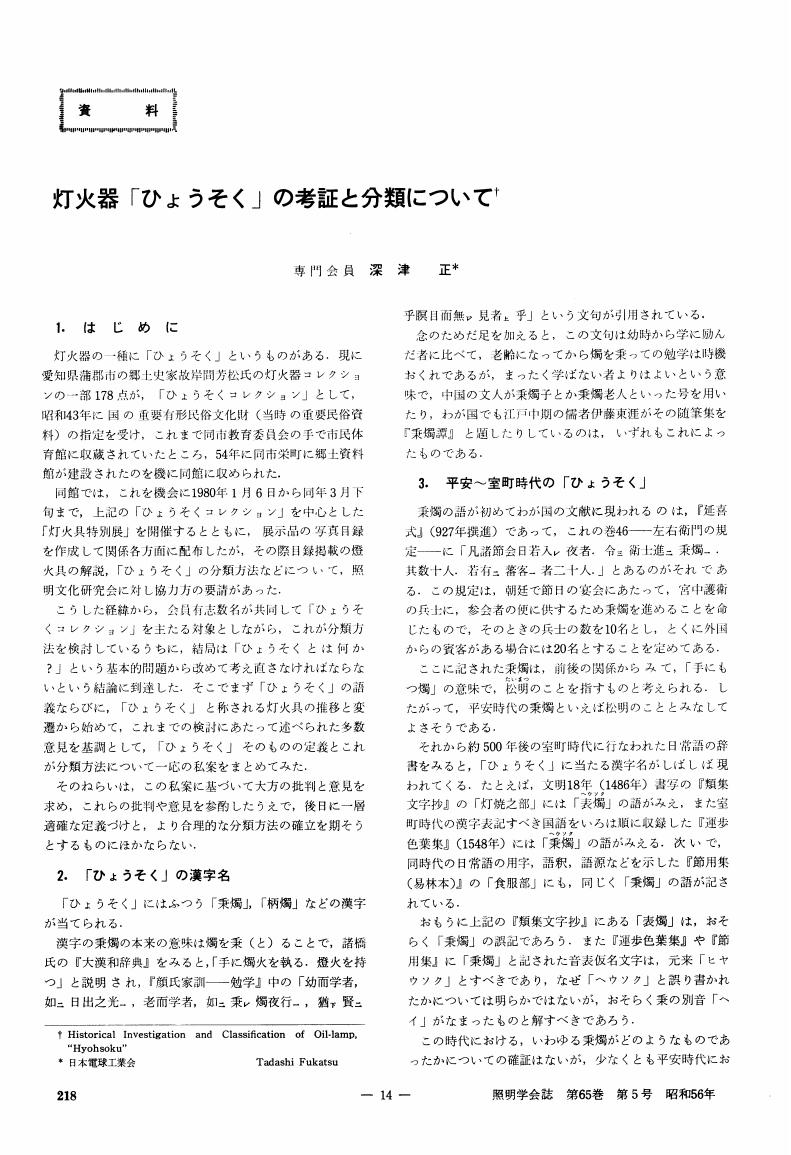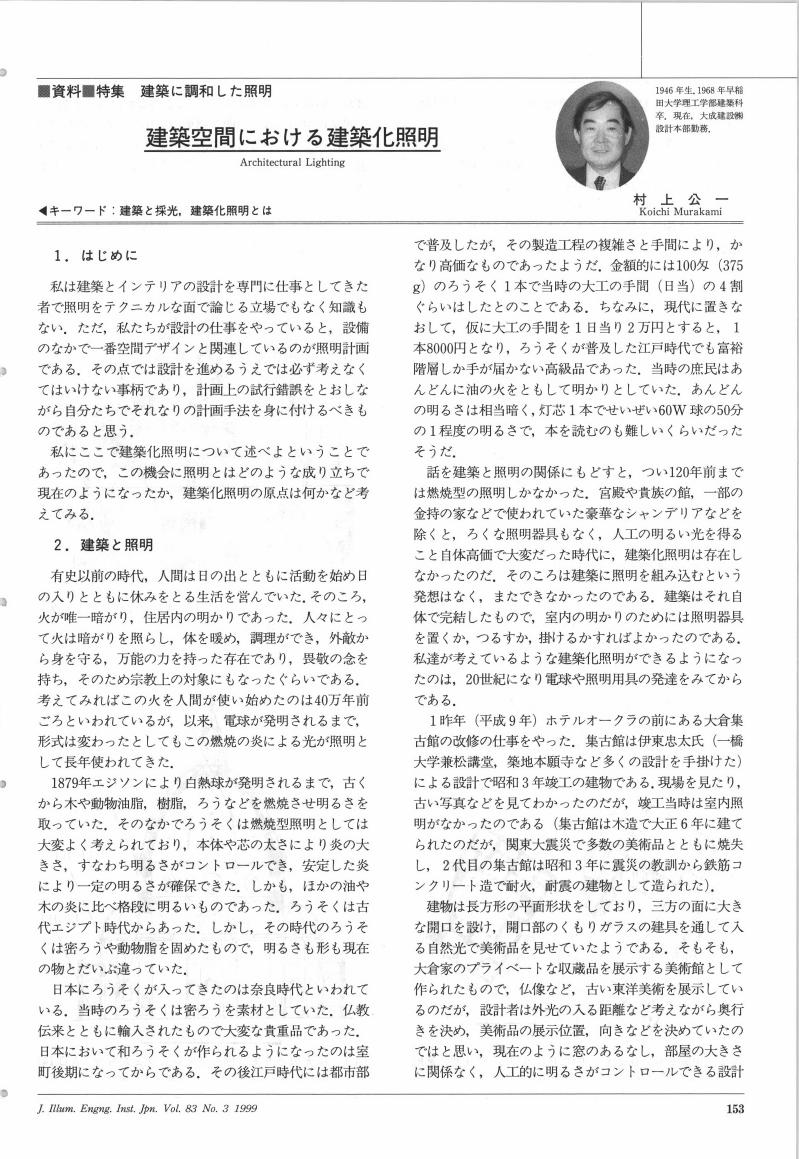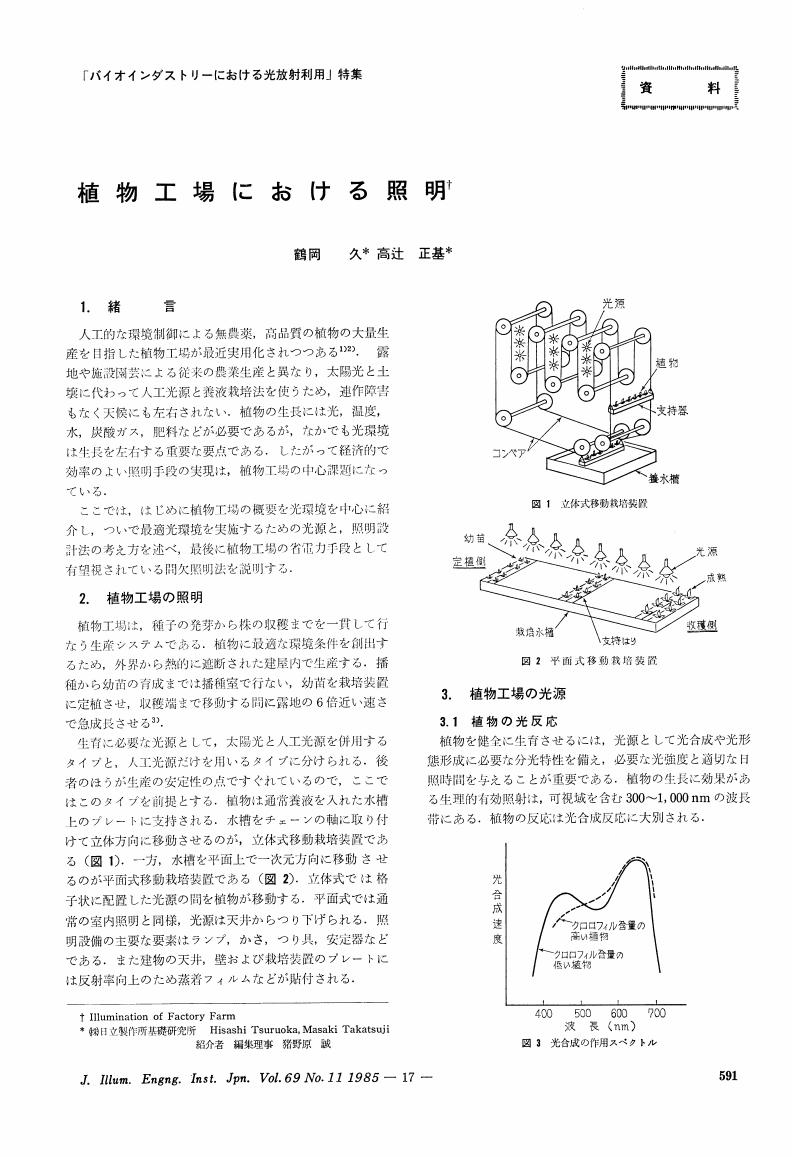- 著者
- 武石 正宣
- 出版者
- 一般社団法人照明学会
- 雑誌
- 照明学会誌 (ISSN:00192341)
- 巻号頁・発行日
- vol.96, no.1, pp.44-46, 2012-01-01
NIIGATA MONOLITH is a comprehensive bridal facility newly built in Niigata prefecture. The ceiling of the banquet room has an inclination of CH:5,700mm to CH:7,300mm, and approximately one thousand transparent acrylic tubes are laid on the ceiling. The challenge was to reduce the running costs including maintenance fees while keeping the ceiling high. HIMEJI MONOLITH is a comprehensive bridal facility built based on an about 80 year-old house by renovating the interior as a guest house. The minimum LED spotlights are used to illuminate the exterior of the building, which received a designation of the Important Building for Landscape of Himeji-shi, Hyogo prefecture.
1 0 0 0 OA 舞台用調光装置について
- 著者
- 築山 敏澄
- 出版者
- 一般社団法人 照明学会
- 雑誌
- 照明学会誌 (ISSN:00192341)
- 巻号頁・発行日
- vol.69, no.7, pp.306-310, 1985-07-01 (Released:2011-07-19)
- 参考文献数
- 9
1 0 0 0 OA マイカル桑名の照明設備
- 著者
- 加藤 昇 中村 肇 長谷川 一兵衛 戸谷 朝子
- 出版者
- 一般社団法人 照明学会
- 雑誌
- 照明学会誌 (ISSN:00192341)
- 巻号頁・発行日
- vol.80, no.Appendix, pp.203, 1996-03-31 (Released:2011-07-19)
1 0 0 0 OA 灯火器「ひょうそく」の考証と分類について
- 著者
- 深津 正
- 出版者
- 一般社団法人 照明学会
- 雑誌
- 照明学会誌 (ISSN:00192341)
- 巻号頁・発行日
- vol.65, no.5, pp.218-222, 1981-05-01 (Released:2011-07-19)
1 0 0 0 OA 白色LED ランプの美術・博物館用照明としての適性 ―天然染料染色布の変退色―
- 著者
- 齊藤 昌子 中村 弥生 森山 厳與 河本 康太郎
- 出版者
- 一般社団法人 照明学会
- 雑誌
- 照明学会誌 (ISSN:00192341)
- 巻号頁・発行日
- vol.98, no.11, pp.585-592, 2014-11-01 (Released:2015-02-02)
- 参考文献数
- 9
- 被引用文献数
- 1
To evaluate the performance of white LEDs as museum lighting, the authors have conducted research and reported on the effect of illuminance level and color temperature on textiles dyed with natural dyes. In this research, four additional white LEDs with various correlated color temperatures and different material constructions and three types of conventional fluorescent lamp were tested yellow textiles that were sensitive to light and ranked in the highly responsive category of the CIE Technical Report (CIE-157-2004) for blue and red dyes. The color degradation degree caused by white LEDs was almost larger than that caused by conventional NU fluorescent lamp. Among the white LEDs, the degradation degree was LED/D (7483K) > LED/UV+RGB (5265K) > LED/B+YAG (5098K) > LED/L (3633K). For the same illuminance level when the content of the 400-500 nm radiation became larger, the degradation degree became larger. When the correlated color temperature was the same, the degradation degree was larger with LED/UV+RGB than with LED/B+YAG. The acceleration degree of degradation differed depending on the LED construction (combination of LED chip and fluorescent material) . From these results, it can be determined that for introducing white LEDs to museum lighting, not only the annual maximum exposure but also the material construction (combination of LED chip and phosphor) should be considered.
1 0 0 0 OA 建築空間における建築化照明
- 著者
- 村上 公一
- 出版者
- 一般社団法人 照明学会
- 雑誌
- 照明学会誌 (ISSN:00192341)
- 巻号頁・発行日
- vol.83, no.3, pp.153-156, 1999-03-01 (Released:2011-07-19)
1 0 0 0 OA Kruithof (クルイトフ) のカーブは正しいか?
- 著者
- 中村 肇
- 出版者
- 一般社団法人 照明学会
- 雑誌
- 照明学会誌 (ISSN:00192341)
- 巻号頁・発行日
- vol.85, no.9, pp.793-795, 2001-09-01 (Released:2011-07-19)
- 参考文献数
- 6
- 被引用文献数
- 4 4
1 0 0 0 OA 透明感のある美しい肌つて?
- 著者
- 上原 静香
- 出版者
- 一般社団法人 照明学会
- 雑誌
- 照明学会誌 (ISSN:00192341)
- 巻号頁・発行日
- vol.86, no.3, pp.197-198, 2002-03-01 (Released:2011-07-19)
- 参考文献数
- 6
- 被引用文献数
- 1
1 0 0 0 OA 植物工場における照明
- 著者
- 鶴岡 久 高辻 正基
- 出版者
- 一般社団法人 照明学会
- 雑誌
- 照明学会誌 (ISSN:00192341)
- 巻号頁・発行日
- vol.69, no.11, pp.591-594, 1985-11-01 (Released:2011-07-19)
- 参考文献数
- 12
1 0 0 0 OA 季節の違いが光環境評価に及ぼす影響 その 1 ― 個人内誤差と個人間誤差 ―
- 著者
- 石田 享子 井上 容子 内山 寛信 倉田 純一
- 出版者
- 一般社団法人 照明学会
- 雑誌
- 照明学会誌 (ISSN:00192341)
- 巻号頁・発行日
- vol.95, no.8A, pp.439-445, 2011-08-01 (Released:2011-10-19)
- 参考文献数
- 7
- 被引用文献数
- 1 1
This study investigates how the season and the correlated color temperature affect the impression of lighting. However, subjective evaluation inevitably has individual variation. Therefore, the purpose of this paper is to clarify how within- and between-subject variation changes. The experiment variables are the season, the illuminance of the room, and the correlated color temperature of the fluorescent lamp. The seasons are summer and winter, there are 12 levels of vertical illuminance of the room from 0.5 to 2000 lx, and the correlated color temperature of the lamps are 3000 and 6700 K. The subjects are 27 to 31 young women. They evaluate brightness, glare, comfort, and relaxation effect of the lighting. In conclusion : 1) Brightness, glare, and comfortable sensations change depending on the illuminance. The influence on the relaxation effect due to the illuminance is small, and the relation is clear for each individual. The subjects have suitable illuminance levels for relaxation. 2) All four items are influenced by the change of illuminance level in between-subject variation. The range of illuminance in which the evaluation between subjects stabilized is as follows: brightness is 500 lx or more, glare is 50 lx or less, comfort is from 20 to 50 lx, and relaxation is from 10 to 20 lx. 3) The variation between individuals is larger than the variation for each individual, though there is little difference with changes in illuminance.
1 0 0 0 OA 照明のデータシート (No.1112)(No.1113)(No.1114)
- 出版者
- 一般社団法人 照明学会
- 雑誌
- 照明学会誌 (ISSN:00192341)
- 巻号頁・発行日
- vol.82, no.9, pp.717-722, 1998-09-01 (Released:2011-07-19)
1 0 0 0 OA 創造的業務における最適な照度および色温度
- 著者
- 三木 光範 谷口 由佳 吉見 真聡
- 出版者
- 一般社団法人 照明学会
- 雑誌
- 照明学会誌 (ISSN:00192341)
- 巻号頁・発行日
- vol.96, no.8A, pp.437-441, 2012-08-01 (Released:2012-10-29)
- 参考文献数
- 13
- 被引用文献数
- 5 2
Improving the lighting environment in offices leads higher levels of intellectual productivity. We constructed a system that provides the individual illuminance and color temperature preferred by workers, and we carried an experiment to clarify which illuminance and color temperature in the office were preferred. The result of this experiment show that each person's favorite lighting environment was different and it changed with their state of health and time of day. We consider that creative works improved when workers were provided with a lighting environment they preferred.
1 0 0 0 OA 白熱電球の歴史(<特集>白熱電球130年の歴史と将来(白熱電球は本当に不要か?))
- 著者
- 渕田 隆義 別所 誠
- 出版者
- 一般社団法人 照明学会
- 雑誌
- 照明学会誌 (ISSN:00192341)
- 巻号頁・発行日
- vol.94, no.6, pp.308-317, 2010-06-01 (Released:2020-10-30)
- 被引用文献数
- 1
Incandescent lamps were invented approximately 130 years ago, and the most intelligent brains of the Europe, US, and Japan worked on incandescent lamp improvements and new product developments. As a result, incandescent lamps came to dominate mainstream illumination systems. Although new light sources such as fluorescent lamps have emerged since then, incandescent lamps have been used everywhere in the world to this day for the unique warm color of their light, and for the cozy feeling they create that people associate with candles and kerosene lamps. However, the 130 year history of incandescent lamps is now coming to an close, due to the significant mission of global warming prevention. From a historical perspective, we are now entering an era of innovation that arrives approximately once every 60 years. It is the dawn of an era of LED illumination that takes advantage of solid-state lighting, which is different from combustion- or electrical-discharge-based lighting. Brilliant researchers and engineers are now starting to work on improvements and refinements of LED lights, the same way their predecessors did 130 years ago. The world will soon be illuminated by the glow of LEDs. This article gives an overview of the history of the incandescent lamp in Japan, and introduces the history of various technologies that supported the development of incandescent lamps.
1 0 0 0 OA 航空障害標識
- 著者
- 黒沢 昌弘
- 出版者
- 一般社団法人 照明学会
- 雑誌
- 照明学会誌 (ISSN:00192341)
- 巻号頁・発行日
- vol.73, no.3, pp.151-154, 1989-03-01 (Released:2011-07-19)
1 0 0 0 OA 東京宝塚ビルの照明設備
- 著者
- 平野 俊明 貴田 弘之
- 出版者
- 一般社団法人 照明学会
- 雑誌
- 照明学会誌 (ISSN:00192341)
- 巻号頁・発行日
- vol.85, no.4, pp.284-287, 2001-04-01 (Released:2011-07-19)
1 0 0 0 OA 照明等演出用設備の伝送規格JATET-L-3010について
- 著者
- 北 博
- 出版者
- 一般社団法人 照明学会
- 雑誌
- 照明学会誌 (ISSN:00192341)
- 巻号頁・発行日
- vol.82, no.4, pp.264-265, 1998-04-01 (Released:2011-07-19)
- 参考文献数
- 3
1 0 0 0 OA 照明のためのパワーエレクトロニクス (3)
- 著者
- 浦山 隆
- 出版者
- 一般社団法人 照明学会
- 雑誌
- 照明学会誌 (ISSN:00192341)
- 巻号頁・発行日
- vol.73, no.4, pp.191-196, 1989-04-01 (Released:2011-07-19)
- 参考文献数
- 2
1 0 0 0 OA エジソンは偉かった!? 人工光源の光と陰
- 著者
- 河本 康太郎
- 出版者
- 一般社団法人 照明学会
- 雑誌
- 照明学会誌 (ISSN:00192341)
- 巻号頁・発行日
- vol.80, no.1, pp.6-11, 1996-01-01 (Released:2011-07-19)
- 参考文献数
- 20
1 0 0 0 所沢市民体育館の照明(照明のデータシート)
- 著者
- 雨貝 雄一
- 出版者
- 一般社団法人照明学会
- 雑誌
- 照明学会誌 (ISSN:00192341)
- 巻号頁・発行日
- vol.89, no.9, pp.617-618, 2005-09-01
この施設の大きな特長は天井トラスに埼玉県秩父産の杉を使用した無垢材による工法が用いられていることで, 約1万本の杉材を1本ずつ, 割れ, 反り, 強度試験を経て合格した材料が使用されている.メインアリーナをはじめ, サブアリーナ, 多目的体育室, トレーニング室, 卓球室などで構成されており, 防災やコミュニティ機能も兼ね備えた施設となっている.
1 0 0 0 イチジクの熟成と日射量の関係に関する統計的考察
- 著者
- 門永 鉄雄 向阪 信一 柳原 等
- 出版者
- 一般社団法人照明学会
- 雑誌
- 照明学会誌 (ISSN:00192341)
- 巻号頁・発行日
- vol.82, no.8, pp.544-550, 1998-08-01
- 被引用文献数
- 2
Japan does not receive enough solar energy to grow figs. By comparing the received solar energy major fig producing areas of the world and Japan, we have derived the supplemental light energy value, which is the minimum additional light energy necessary for optimal fig maturation. By supplementing natural sunlight with this optimum value by electrical lighting, the fig season in Japan can be lengthened, crop volume increased, and fruit quality improved. The optimum period for fig maturation in Nagoya is from June to September, when the minimum temperature remains above 20℃ in Nagoya, Athens, Izmir, and San Diego. During this same period, however, Athens receives direct sunlight for approximately 1,308hours, while Nagoya gets approximately 638 hours, i.e.about 49% of Athens.These four months also provide average estimated solar energy levels of 17.5 MJ・m^<-2>・day^<-1> for Athens, 15.3MJ・m^<-2>・day^<-1> for San Diego, and 8.8MJ・m^<-2>・day^<-1> for Nagoya. A normal cultivation environment from January to March in winter will require additional supplemental light energy 5.1MJ・m^<-2>・day^<-1> which is derived from the difference in the solar energy between 8.8MJ・m^<-2>・day^<-1> for outdoor maturation in Nagoya and 3.7MJ・m^<-2>・day^<-1> for a green house in winter.












